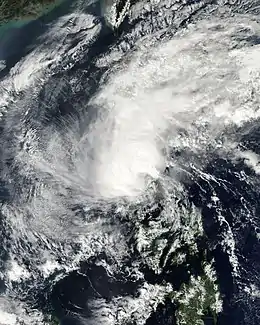List of Western Pacific tropical depressions
A tropical depression is a tropical cyclone that reaches maximum sustained winds below 34 knots (39 mph; 63 km/h). The Japan Meteorological Agency (JMA) is the main weather forecasting agency in the Pacific Northwest Pacific basin, where it measures sustained winds by averaging wind speeds in a period of ten minutes. The basin is limited to the north of the equator between the 100th meridian east and the 180th meridian.

Background
| Category | Sustained winds |
|---|---|
| Violent Typhoon | ≥105 knots ≥194 km/h |
| Very Strong Typhoon | 85–104 knots 157–193 km/h |
| Typhoon | 64–84 knots 118–156 km/h |
| Severe Tropical Storm | 48–63 knots 89–117 km/h |
| Tropical Storm | 34–47 knots 62–88 km/h |
| Tropical Depression | ≤33 knots ≤61 km/h |
The Northwest Pacific basin covers a vast area in the Pacific Ocean, located north of the equator, between 100°E and 180°E.[1] Several weather agencies monitor this basin, however it is officially monitored by the Japan Meteorological Agency (JMA, RSMC Tokyo), who is responsible for forecasting, naming and issuing warnings for tropical cyclones.[1] Unofficially, the Joint Typhoon Warning Center also monitors the basin, however these warnings measures 1-minute sustained wind speeds, comparing their scale to the Saffir–Simpson scale.[2] The JMA uses a simpler scale on classifying tropical cyclones adapted by the ESCAP/WMO Typhoon Committee measuring 10-minute sustained wind speeds, ranging from a tropical depression, tropical storm, severe tropical storm and typhoon.[3] Furthermore, the JMA divides the typhoon category into three sub-categories for domestic purposes – a strong typhoon, very strong typhoon and violent typhoon.[3]
This article covers a list of systems developing in the Northwest Pacific basin that were classified by the category of a tropical depression by the JMA, JTWC and PAGASA. The category of a tropical depression ranges with sustained winds of below 34 knots (63 km/h; 39 mph).[3] Just to note that this article only lists tropical depressions that were named, designated and systems that affected any land masses.
Systems
2020s
| Name | System dates | Sustained wind speeds |
Pressure | Areas affected | Damage (USD) |
Deaths | Refs |
|---|---|---|---|---|---|---|---|
| Carina | July 11 – 15, 2020 | <55 km/h (35 mph) | 1004 hPa (29.65 inHg) | Philippines, Taiwan | None | None | |
| TD | July 27 – 29, 2020 | Not specified | 1010 hPa (29.83 inHg) | None | None | None | |
| Gener | August 9 – 13, 2020 | 55 km/h (35 mph) | 1012 hPa (29.83 inHg) | None | None | None | |
| 12W | September 10 – 12, 2020 | 55 km/h (35 mph) | 1006 hPa (29.71 inHg) | Japan | None | None | |
| TD | September 27 – 29, 2020 | Not specified | 1000 hPa (29.53 inHg) | None | None | None | |
| Pepito | October 13 – 16, 2020 | 55 km/h (35 mph) | 1002 hPa (29.65 inHg) | Philippines, Vietnam | $187 thousand | None | |
| 20W | October 19 – 23, 2020 | 55 km/h (35 mph) | 1006 hPa (29.71 inHg) | None | None | None | |
| TD | December 5 – 6, 2020 | Not specified | 1010 hPa (29.83 inHg) | None | None | None | |
| TD | December 29, 2020 | Not specified | 1004 hPa (29.65 inHg) | None | None | None | |
| TD | January 19 – 20, 2021 | <55 km/h (35 mph) | 1008 hPa (29.77 inHg) | Philippines | $10.8 million | 1 | |
References
- WMO/ESCP Typhoon Committee (2019). Typhoon Committee Operational Manual Meteorological Component 2019 (PDF) (Report). World Meteorological Organization. pp. 1–7, 33–34. Retrieved April 29, 2020.
- Joint Typhoon Warning Center (2008-03-31). "What are the description labels used with tropical cyclones by JTWC?". Joint Typhoon Warning Center – Frequently Asked Questions (FAQ). Retrieved 2008-12-22.
- Typhoon Committee (2015). Typhoon Committee Operational Manual 2015 (PDF) (Report). World Meteorological Organization. Retrieved November 13, 2015.